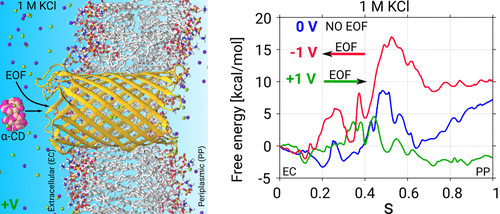当前位置:
X-MOL 学术
›
J. Phys. Chem. B
›
论文详情
Our official English website, www.x-mol.net, welcomes your
feedback! (Note: you will need to create a separate account there.)
Voltage-Dependent Transport of Neutral Solutes through Nanopores: A Molecular View
The Journal of Physical Chemistry B ( IF 2.8 ) Pub Date : 2020-11-11 , DOI: 10.1021/acs.jpcb.0c08401 Jigneshkumar Dahyabhai Prajapati 1 , Ulrich Kleinekathöfer 1
The Journal of Physical Chemistry B ( IF 2.8 ) Pub Date : 2020-11-11 , DOI: 10.1021/acs.jpcb.0c08401 Jigneshkumar Dahyabhai Prajapati 1 , Ulrich Kleinekathöfer 1
Affiliation

|
The permeation of (neutral) molecules through nanopores in the presence of external voltages depends on several factors including pore electrostatics, electrophoretic force, and electro-osmotic drag. In earlier single-channel electrophysiology experiments, voltage-dependent asymmetric transport of neutral α-cyclodextrin (α-CD) molecules through the biological nanopore ΔCymA was observed. The voltage-dependent ion-associated flow of water, the so-called electro-osmotic flow, has been suggested to be the key factor behind the observed asymmetric behavior. The influence of pore electrostatics and electrophoretic force and their interplay with the electro-osmotic drag with varying buffers and voltages has not yet been analyzed at the molecular level. Hence, the detailed physical mechanism behind this intriguing permeation process is in part still unclear. In the present study, we have performed 36 μs all-atom free energy calculations by combining applied-field molecular dynamics simulations with metadynamics techniques. The influence of several ionic conditions as well as external voltages on the permeation of α-CD molecules across the ΔCymA pore has been investigated. To decipher the thermodynamic and kinetic details, the lowest energy paths and the permeation times for α-CD translocation have been estimated. In the presence of KCl or MgCl2 salts, the charge of the cations is found to control the direction and magnitude of the electro-osmotic flow, which in turn strongly affects α-CD permeation. Overall, the present findings significantly improve the fundamental understanding of the voltage-dependent transport of neutral solutes across nanopores.
中文翻译:

中性溶质通过纳米孔的电压依赖性转运:分子观点
在存在外部电压的情况下,(中性)分子通过纳米孔的渗透取决于多种因素,包括孔隙静电,电泳力和电渗透阻力。在较早的单通道电生理实验中,观察到中性α-环糊精(α-CD)分子通过生物纳米孔ΔCymA的电压依赖性不对称转运。电压依赖性离子相关的水流,即所谓的电渗流,被认为是观察到的不对称行为背后的关键因素。尚未在分子水平上分析孔隙静电和电泳力的影响以及它们与具有不同缓冲液和电压的电渗透阻力的相互作用。因此,有趣的渗透过程背后的详细物理机制尚不清楚。在本研究中,我们通过将应用领域的分子动力学模拟与元动力学技术相结合,进行了36 s的全原子自由能计算。研究了几种离子条件以及外部电压对α-CD分子穿过ΔCymA孔的渗透的影响。为了解释热力学和动力学的细节,已经估计了α-CD易位的最低能量路径和渗透时间。在氯化钾或氯化镁存在下 研究了几种离子条件以及外部电压对α-CD分子穿过ΔCymA孔的渗透的影响。为了解释热力学和动力学的细节,已经估计了α-CD易位的最低能量路径和渗透时间。在氯化钾或氯化镁存在下 研究了几种离子条件以及外部电压对α-CD分子穿过ΔCymA孔的渗透的影响。为了解释热力学和动力学的细节,已经估计了α-CD易位的最低能量路径和渗透时间。在氯化钾或氯化镁存在下在2种盐中,发现阳离子的电荷可控制电渗流的方向和大小,进而强烈影响α-CD的渗透。总体而言,目前的发现大大改善了对中性溶质跨纳米孔的电压依赖性传输的基本理解。
更新日期:2020-11-25
中文翻译:

中性溶质通过纳米孔的电压依赖性转运:分子观点
在存在外部电压的情况下,(中性)分子通过纳米孔的渗透取决于多种因素,包括孔隙静电,电泳力和电渗透阻力。在较早的单通道电生理实验中,观察到中性α-环糊精(α-CD)分子通过生物纳米孔ΔCymA的电压依赖性不对称转运。电压依赖性离子相关的水流,即所谓的电渗流,被认为是观察到的不对称行为背后的关键因素。尚未在分子水平上分析孔隙静电和电泳力的影响以及它们与具有不同缓冲液和电压的电渗透阻力的相互作用。因此,有趣的渗透过程背后的详细物理机制尚不清楚。在本研究中,我们通过将应用领域的分子动力学模拟与元动力学技术相结合,进行了36 s的全原子自由能计算。研究了几种离子条件以及外部电压对α-CD分子穿过ΔCymA孔的渗透的影响。为了解释热力学和动力学的细节,已经估计了α-CD易位的最低能量路径和渗透时间。在氯化钾或氯化镁存在下 研究了几种离子条件以及外部电压对α-CD分子穿过ΔCymA孔的渗透的影响。为了解释热力学和动力学的细节,已经估计了α-CD易位的最低能量路径和渗透时间。在氯化钾或氯化镁存在下 研究了几种离子条件以及外部电压对α-CD分子穿过ΔCymA孔的渗透的影响。为了解释热力学和动力学的细节,已经估计了α-CD易位的最低能量路径和渗透时间。在氯化钾或氯化镁存在下在2种盐中,发现阳离子的电荷可控制电渗流的方向和大小,进而强烈影响α-CD的渗透。总体而言,目前的发现大大改善了对中性溶质跨纳米孔的电压依赖性传输的基本理解。











































 京公网安备 11010802027423号
京公网安备 11010802027423号